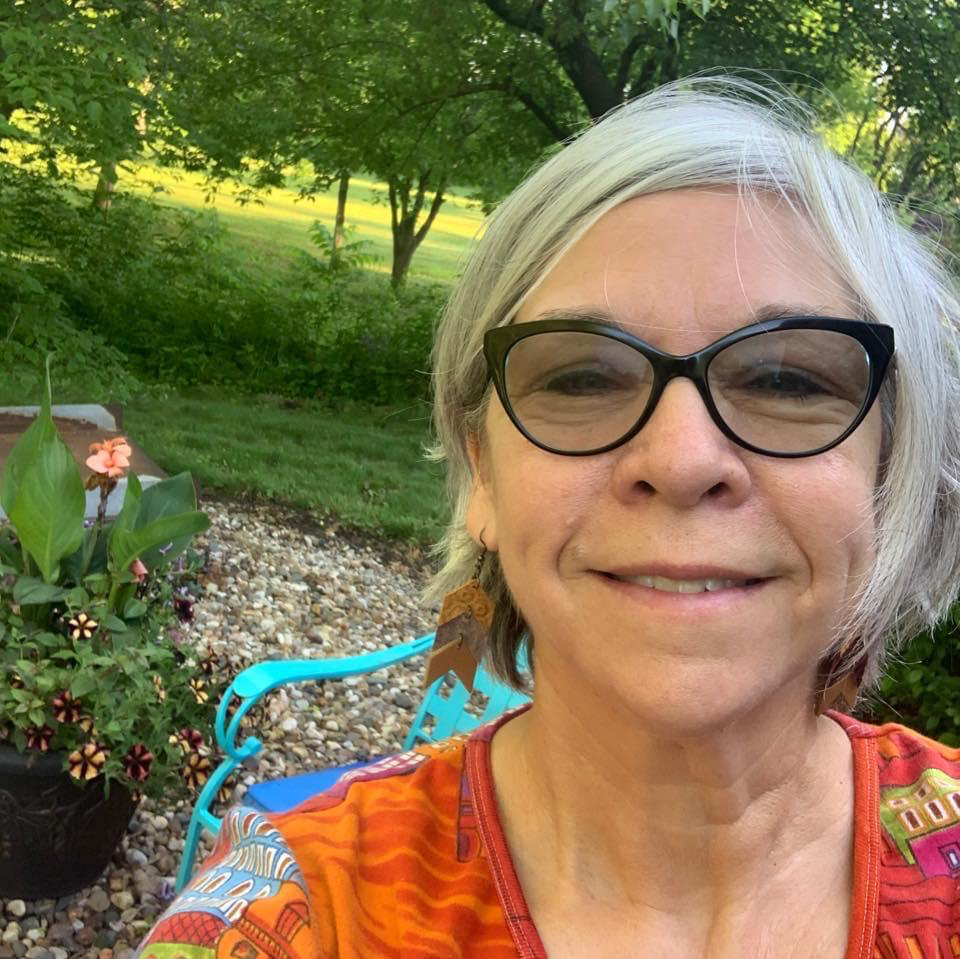
Transitions: Robin Dickerson, BSRT, RRT
The AARC community lost a dedicated leader when Robin Dickerson, BSRT, RRT, lost her life and her husband in a tragic motorcycle accident while traveling in the Bighorn Mountains of Wyoming in early July. She was 57 years old.
 Robin Dickerson’s daughter provided us with this photo of her mom, featuring her in front of her beloved patio at her home in Plattsburg, MO.
Robin Dickerson’s daughter provided us with this photo of her mom, featuring her in front of her beloved patio at her home in Plattsburg, MO.An active member of the Missouri Society for Respiratory Care (MSRC) who served as treasurer in 2012-2014, she worked with the society in a wide variety of other capacities over the years. Dickerson was serving as director of professional and clinical education and manager of clinical and sales training at Sentec at the time of her death.
Before joining the company in 2018, she held various industry positions with Fisher and Paykel, Philips Healthcare/Diametrics, Instrumentation Laboratory, and Tyco Healthcare.
Earlier in her career, Dickerson served as staff development coordinator for respiratory therapy at the Kansas University Medical Center and an instructor at Durham Tech Community College. She graduated Summa Cum Laude from the College of St. Mary in 1985.
She lifted them up
Dickerson’s colleagues at Sentec remember her as someone who lifted them and supported their careers through education and encouragement and exemplified leadership characteristics. They call her an advocate for the field of respiratory therapy who saw the value in what therapists could do with their knowledge and skills.
“Robin gave, day after day, unselfish, overextended, genuine support to all those around her,” said one coworker, noting she exhibited genuine joy in seeing others learn and always maintained a humble, “keep it real” style that was highly appreciate by those she worked with.
Chris Estes, president and general manager at Senzime, says she took her profession seriously and firmly believed that the education she provided to clinicians would result in better care for patients.
“She was a tireless servant and would travel anywhere, anytime, to support our customers and the patients they served,” he said.
Her long-time friend and colleague, Patrice Johnson, MBA, RRT, RRT-NPS, who knew Dickerson for some 25 years, cites her incredible work ethic as something everyone admired.
“She was passionate about respiratory care and enthusiastically shared her knowledge with others,” she said.
Everyone sought her out
Kyle Kern, MS, RRT, who worked with Dickerson through the MSRC, believes she will be remembered as a strong advocate not only for the field of respiratory care but also for the patients of all the respiratory therapists out there today. She’ll also be remembered for reaching out to her colleagues, especially those new to the profession.
“Robin was active within the MSRC when I first became active right after graduation in 2010,” he said. He appreciated the warm welcome she extended to new members, her willingness to help anyone who needed it, and the straightforward way she shared her opinions in discussions.
“I always had a high level of respect for her and her knowledge,” he said.
Two other colleagues in the MSRT, Sherry Whiteman, MS, RRT, and Robin Kidder, MA, RRT, AE-C, who now serves as president of the society, recall Dickerson as someone who everyone sought out for advice — and for fun too.
“I would always see Robin at our conferences, always trying to teach new and established therapists the newest research and innovations available,” Kidder said. “She always had a smile on her face, and people flocked to hang out with her because of her fun, witty, and charming personality.”
Said Whiteman, “I will always remember Robin as someone I could go to for guidance and who I always ended up sharing a smile and a laugh with. No matter the topic, we always ended up laughing together and I always felt better after talking with her. Robin was a calm, level-headed voice of reason I could count on.”
Preterm Infants Getting Better Respiratory Care
New research based on data collected on one million preterm infants born between 2008 and 2018 finds respiratory care for these infants has markedly improved.
Investigators led by a team from Vanderbilt University specifically examined the use of respiratory support for these infants, with results showing a 10% decline in the use of mechanical ventilation over the 10-year period. At the same time, the use of noninvasive respiratory support, such as CPAP, went up.
Overall, the numbers indicate about 30,000 fewer infants were placed on mechanical ventilation during the study period. The time infants spent on mechanical ventilation decreased as well.
Not all infant groups saw a decline in mechanical ventilation, however. For example, a separate look at extremely preterm infants born at 22-24 weeks gestation found an increase in the use of mechanical ventilation in that group. The authors believe this reflects increased intervention and improved survival for this population. It also suggests more examination is needed for respiratory strategies related to this group.
“The field of neonatology has worked really hard to examine our practices and get better. I am proud of how quickly some of the landmark respiratory care studies have penetrated our clinical care,” said study author Dupree Hatch, MD, MPH. “Care in the NICU is becoming less invasive and gentler because it is the right thing to do for babies’ long-term outcomes.”
JAMA Pediatrics published the study on July 6.
COVID-19 Risks in Younger People
Thanks to a robust vaccination rate among those 65 and older and the more highly contagious Delta variant, hospitals are filling up with more younger, unvaccinated people with COVID-19. New research out of the Mayo Clinic offers some insight into the risk factors associated with severe infection in this population.
The study was based on data from 9,859 COVID-19 infections. It was included in the Rochester Epidemiology Project, which links 1.7 million medical records from multiple health care systems. Being part of this system helps provide a complete picture of risks for people living in a 27-county region covering Southeast Minnesota and West Central Wisconsin surrounding the Mayo Clinic in Rochester. Among the results —
- People younger than 45 who had cancer or heart disease or blood, neurologic, or endocrine disorders had more than a threefold change for increased risk of severe infection.
- While cancer was a strong risk factor for people younger than 45, it was not a significant factor for the older age group.
- Among patients with chronic conditions, those with developmental disorders, personality disorders, schizophrenia, and other psychoses had the highest adjusted risk for severe COVID-19.
- Though they made up only 4.1% of the study population, Asian Americans had the highest risk of severe COVID-19. This risk is followed by Black Americans, making up 11.5% of the severe cases. Patients of Hispanic ethnicity were also associated with a higher risk of severe infection.
The Mayo Clinic Proceedings published the study.
Could Pulmonary Endothelial Cell Treatment Benefit Patients with COPD?
In a study conducted in mice, scientists from Weill Cornell Medicine have discovered that pulmonary endothelial cell injections can reverse the symptoms of emphysema.
The research began when the investigators found reduced levels of various markers needed for healthy endothelial cells in the lungs of COPD patients and the lungs of laboratory mice with an induced form of emphysema. The cells taken from mice included several genes associated with inflammation, cell death, and vascular remodeling.
“We took these features to denote a potentially dysfunctional state that could drive the development of emphysema,” said co-senior author Dr. Shahin Rafii. “This could indicate that reestablishing a healthy vasculature — by either intravenous delivery of normal lung endothelial cells or reversing aberrant endothelial cell signaling — could encourage repair and regeneration of damaged lung tissue.”
The team decided to try injecting healthy lung endothelial cells into the mice, and it worked. This process resulted in a reduction in alveolar destruction associated with emphysema and restored lung function.
From there, they looked at a cell-signaling protein called leucine-rich alpha-2-glycoprotein-1 (LRG1), finding that it was elevated in the endothelial cells of patients with COPD. When they removed LRG1 from the endothelial cells of the mice, they were protected from the tissue destruction associated with emphysema.
“Taken together, our data strongly suggest the critical role of endothelial cell function in mediating the pathogenesis of COPD/emphysema,” said co-first author Dr. Alexandra Racanelli. “Targeting endothelial cell biology by administering healthy lung endothelial cells and/or inhibiting the LRG1 pathway may therefore represent strategies of immense potential for the treatment of patients with advanced COPD or emphysema.”
The study appeared in the Journal of Experimental Medicine on July 21.
We’re Not There Yet
Is your hospital ready for another pandemic? Probably not, report researchers from the University of Maryland who developed a tool called the Hospital Medical Surge Preparedness Index (HMSPI) using data from 2005 to 2014 on more than 6,200 hospitals nationwide. The investigators took four major metrics into account as they scored the ability of hospitals to handle a sudden influx of patients —
- Metric 1 – Staff: Doctors, nurses, pharmacists, respiratory professionals, and others
- Metric 2 – Supplies: Personal protective equipment, cardiac monitors, sterile bandages, and ventilators
- Metric 3 – Space: Total beds and number of beds that current staff can handle
- Metric 4 – Systems: Framework for enabling electronic sharing of files and information between departments and multiple hospitals
While all the hospitals improved over the study period, no state reached ideal readiness.
“We need to better understand the ability of our nation’s hospitals to save lives in times of crisis,” said study author David Marcozzi, MD. ”The COVID-19 pandemic demonstrated that there is still plenty of room for improvement in the ability of our nation’s health care system to triage and manage multiple patients in a crisis, and that translates into lives lost unnecessarily. Our research is dedicated to those who lost their lives in this tragedy and other mass casualty events. We can do better.”
The Journal of Healthcare Management published the research.
Inhaled COVID-19 Vaccine in the Works
Investigators from the University of Iowa and University of Georgia are working on an inhaled COVID-19 vaccine. In trials conducted in mice and ferrets, the vaccine — similar to the inhaled influenza vaccines — produced a localized immune response and completely protected the mice from fatal doses of SARS-CoV-2.
Similar results were seen in the ferrets, and in ferrets, the vaccine also appeared to block transmission of COVID-19 from infected animals to their unprotected and uninfected cage-mates.
The vaccine uses a harmless parainfluenza virus 5, or PIV5, to deliver the SARS-CoV-2 spike protein directly into the mucosal cells lining the nasal passages and airways, considered the main entry points for most SARS-CoV-2 infections. The study authors believe the one-dose vaccine, which can be stored at room temperature, might play a big role in getting COVID-19 under control in parts of the world that remain largely unvaccinated.
The research appears in Science Advances on July 2.
Email newsroom@aarc.org with questions or comments, we’d love to hear from you.












